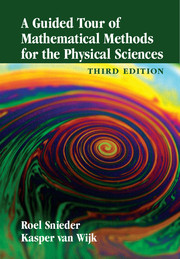Book contents
- Frontmatter
- Contents
- List of figures
- List of tables
- About the authors
- 1 Introduction
- 2 Dimensional analysis
- 3 Power series
- 4 Spherical and cylindrical coordinates
- 5 Gradient
- 6 Divergence of a vector field
- 7 Curl of a vector field
- 8 Theorem of Gauss
- 9 Theorem of Stokes
- 10 The Laplacian
- 11 Scale analysis
- 12 Linear algebra
- 13 Dirac delta function
- 14 Fourier analysis
- 15 Analytic functions
- 16 Complex integration
- 17 Green's functions: principles
- 18 Green's functions: examples
- 19 Normal modes
- 20 Potential field theory
- 21 Probability and statistics
- 22 Inverse problems
- 23 Perturbation theory
- 24 Asymptotic evaluation of integrals
- 25 Conservation laws
- 26 Cartesian tensors
- 27 Variational calculus
- 28 Epilogue, on power and knowledge
- References
- Index
19 - Normal modes
Published online by Cambridge University Press: 05 March 2015
- Frontmatter
- Contents
- List of figures
- List of tables
- About the authors
- 1 Introduction
- 2 Dimensional analysis
- 3 Power series
- 4 Spherical and cylindrical coordinates
- 5 Gradient
- 6 Divergence of a vector field
- 7 Curl of a vector field
- 8 Theorem of Gauss
- 9 Theorem of Stokes
- 10 The Laplacian
- 11 Scale analysis
- 12 Linear algebra
- 13 Dirac delta function
- 14 Fourier analysis
- 15 Analytic functions
- 16 Complex integration
- 17 Green's functions: principles
- 18 Green's functions: examples
- 19 Normal modes
- 20 Potential field theory
- 21 Probability and statistics
- 22 Inverse problems
- 23 Perturbation theory
- 24 Asymptotic evaluation of integrals
- 25 Conservation laws
- 26 Cartesian tensors
- 27 Variational calculus
- 28 Epilogue, on power and knowledge
- References
- Index
Summary
Many physical systems can only oscillate at certain specific frequencies. As a child (and hopefully also as an adult), you observed that a swing in a playground moves only with a specific natural period, and that the force pushing the swing is only effective when the period of the force matches the period of the swing. The patterns of motion at which a system oscillates are called the normal modes of the system. A swing has one normal mode (Section 17.1), but you have seen in Section 12.5 that a simple model of a tri-atomic molecule has three normal modes. An example of the normal modes of a system is given in Figure 19.1, which shows the pattern of oscillation of a metal plate driven by an oscillator at six different frequencies. The screw in the middle of the plate shows the point at which the force on the plate is applied, and before any force is applied, sugar is evenly sprinkled on the plate. When an external force is applied at the frequency of one of the normal modes of the plate, oscillations of the plate result in a pattern of motion with nodal lines. These nodal lines define where the motion vanishes and as a result the sugar on the plate collects at these lines.
In this chapter, the normal modes of a variety of systems are analyzed. Normal modes play an important role in many applications, because the frequencies of normal modes provide important information about physical systems. Examples include the spectral lines of the light emitted by atoms, which have led to the advent of quantum mechanics and its description of the structure of atoms. In another example, the normal modes of the Earth provide information about the internal structure of our planet. In addition, normal modes are used in this chapter to introduce some properties of special functions, such as Bessel and Legendre functions.
- Type
- Chapter
- Information
- A Guided Tour of Mathematical Methods for the Physical Sciences , pp. 303 - 344Publisher: Cambridge University PressPrint publication year: 2015



